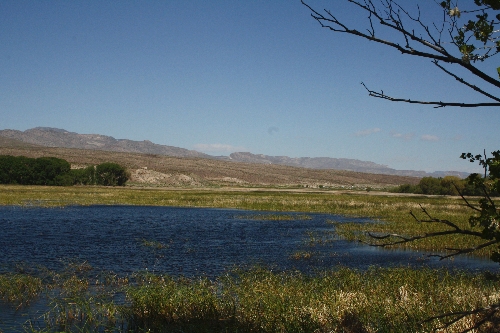Bird haven can be a human haven any time of year

Pahranagat National Wildlife Refuge was established in 1963 to provide a wintering habitat for migratory birds, including a large variety of waterfowl. "Pahranagat" is a Paiute word meaning "valley of shining water." The refuge encompasses about 5,380 acres of lakes, cattail marshes, wet meadows, riparian habitats and even desert uplands. The three largest bodies of water on the refuge are Upper Lake, Middle Pond and Lower Lake.
Located at an elevation of about 3,300 feet just south of the ranching town of Alamo, it’s usually about five to 10 degrees cooler than Las Vegas and therefore pleasant enough to visit even in winter if you dress appropriately for the season. Be aware that waterfowl and upland bird hunting are allowed in the refuge at certain times during the cold months.
The location lies on the Pacific Flyway, which stretches from Alaska and Canada to Mexico, so at least 230 different species of birds visit the refuge throughout the year. Migratory birds include greater sandhill cranes which travel here from February to March and again in October and November. Sandhill cranes are a sight to behold and often congregate in large numbers. They may have a wingspan of more than six feet. The Tundra swans, golden eagles and bald eagles are also winter visitors. So are red-tailed hawks, northern harriers, Cooper’s hawks and American kestrels.
The refuge has such a variety of habitat that many kinds of birds might be found there at any time, including warblers, orioles, flycatchers and finches that enjoy the cottonwoods and willow thickets.
A few weeks ago, a friend and I kayaked in Upper Lake and found this was not only a great way to explore the lake but also to spot birds that we might not have seen from the shore. Wading birds, including great blue herons, egrets and American avocets, frequent the shallows. Only non-motorized boats or those with electric motors are allowed on the refuge. You can launch at Upper Lake, Middle Pond and Lower Lake year-round. The North Marsh is closed to all boats.
There are no official boat launching facilities, but there are plenty of parking places along the access road, and from those, it’s easy to carry a small craft the short distance to water.
Mammals on the refuge include coyotes, kit foxes, mule deer and mountain lions. In the desert upland areas of the park you might also find the Mojave rattlesnake, desert tortoise or a greater roadrunner. Just driving by the Upper Lake you can often see beaver lodges.
Deborah Wall is the author of "Great Hikes, A Cerca Country Guide" and "Base Camp Las Vegas: Hiking the Southwestern States," published by Stephens Press. She can be reached at deborabus@aol.com.